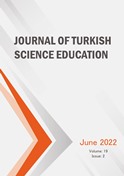The Effect of Smartphone Usage Intensity on High School Students' Higher Order Thinking Skills in Physics Learning
Research Article
Abstract
Smartphones are no longer just a communication tool, but also a means of exchanging information by students. Hence, smartphones may also positively contribute upon higher order thinking skills (HOTS) of students in physics learning. This research aimed to determine the smartphone usage intensity, the HOTS level of students, and the effect of the smartphone usage intensity on students' HOTS in physics learning. The data of smartphone usage intensity was obtained using a questionnaire and students' HOTS were obtained through solving physics HOTS test. The results of this research indicate that the smartphone usage intensity and the HOTS level of students in physics learning are in high and low categories with percentages of 48.72% and 51.28%, respectively. Therefore, students' HOTS are affected by the intensity of the use of smartphones in physics learning by 21.07%. These results indicate that the smartphone usage intensity of most students is very high, but not yet able to contribute optimally to the students' HOTS. Therefore, there needs to be a special treatment in utilizing smartphones in physics learning to optimize the students' HOTS.
